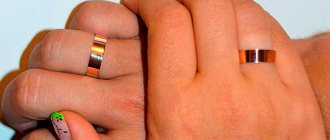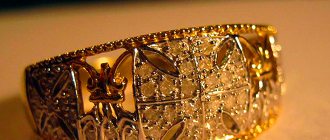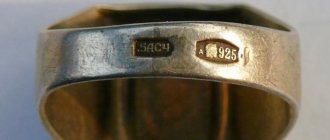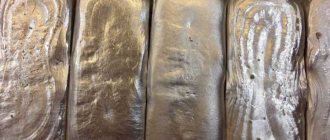Before buying a precious metal, you need to study its external signs. A stamp is required. This will mean that the jewelry meets the metal purity rating system. The standard defines several types of samples. Each contains an encrypted amount of pure gold. Among the well-known designations (585, 750, etc.) you can also find less common ones.
There is a 555 probe, but few people know what is encrypted in it. Theoretically, this could be a hallmark of the purity of the precious metal, but not everything is so simple. You need to find out what types of samples there are according to GOST, and whether the option under consideration applies to them.
Branding methods
Previously, jewelry was marked with a convex test. Later, its appearance was changed, as was the method of application. Technologies used today:
- impact method: was popular earlier, based on mechanical impact on metal with a self-made impact stamp;
- electroerosion (electric spark method): this option has many advantages, they note that there is no risk of severe deformation of the metal, creating zones of concentration of internal stress, as a result, they receive a mark with a depth of 0.1 to 1 mm, and the best characteristics are distinguished by a test made on a hot, colored metal, as well as when applied using a press;
- laser engraving: the technology ensures high precision of execution, which allows it to be used for making micro-stamps, the laser beam is considered the thinnest tool, it is used to make signs up to 1 mm in size, this is the method that has become widespread today, in addition, there is another factor that indicates about the wide capabilities of the laser - non-contact implementation.
Jewelry mark
Care, cleaning and storage of gold-plated items
In order for your jewelry to last as long as possible, you must follow a few simple rules for caring for gold plating.
| Wearing | Be sure to remove gold-plated jewelry before any contact with water (shower, swimming pool, washing dishes) or sports activities. Avoid contact with cosmetics. Don't forget that everyday wear shortens their service life. |
| Storage | Store only in a separate box or fabric bags so as not to damage the layer with other decorations. |
| Cleaning | Clean only with a soft cloth without using abrasives. If dark spots just appear, just wipe with ordinary vinegar and rinse in water. The shine will help return the egg white (after it you will also need to rinse in clean water). Once a year, items should be taken to a jeweler for professional cleaning. |
Despite the fact that sooner or later the coating wears off, it can always be renewed in a jeweler’s workshop.
Sample 5S5: various hypotheses of formation
The cost of products marked with the 5S5 designation is often lower than certified products offered in stores. This feature can be explained by various reasons:
- the number in 585 sample, erased from age: in composition, the metal with the designation 5S5 or 555 fully corresponds to this alloy, this means that it contains 585 g of gold, respectively, the changed number is a consequence of abrasion of the material, for example, under regular mechanical action;
- the result of application through a stencil using the electric spark method: as wear progresses, traces of use appear, for example, sometimes white metal turns yellow when the surface layer is erased; in the same way, a sample made in an insufficiently reliable way loses its outline and depth over time (for example, with regular self-grinding inappropriate ways);
- 5S5 is a fake of scammers: this combination of numbers and letters vaguely resembles the designation 585, if the sample is applied at a shallow depth or has small dimensions, and is also located in an area of complex configuration, it is unlikely to be examined without a magnifying glass, this is what unscrupulous sellers are counting on To avoid purchasing a low-quality product, it is recommended to study the appearance of the jewelry more carefully; you do not need to completely rely on the advice of a jewelry store employee;
- 5S5 is a quality mark from the Assay Office: many people mistakenly believe that a sample containing a letter is a special mark that is placed by the supervisory authority, thus determining the quality of the jewelry; in fact, you need to look for other reasons for the appearance of such a designation, because on All gold products are affixed by the government agency (Federal Assay Office) with standard seals according to the precious metal content.
Carat system
It has been widespread in America, as well as in Europe and Asia for about a century. According to it, gold with 99.9% in the alloy can be considered completely pure, which is identical to 24k. Further figures in descending order are 23, 22, 18, 14, 12, 9 and 8 carats.
Metric system
The most popular method of calculation today due to its accuracy and convenience. Shows how many percent of gold, without taking into account the ligature, contains 1000 weight particles of the alloy, or the amount of gold metal in 1 g of jewelry. The following scale for measuring gold hallmarks has been established: 375, 500, 583, 585, 750, 916, 958, 999.
Spool system
It was in active use during the times of Ancient Rus'. The Russian pound measuring 96 spools was taken as a basis. The number 96 indicated on the stamp meant that the alloy was 99.9% yellow metal. In second place was the indicator 36. To convert to the modern karate system, the indicator indicated on the engraving is divided by 4.
Lot system
It was in use in medieval Europe. Back then, jewelers measured the weight of the product in marks, each of which consisted of 16 lots. Gold was hallmarked with hallmarks of 6, 8, 12, 14, 16. To convert lots into carats, their indicator was multiplied by 125 and divided by 2.
Over time, the system was improved, and it became easier to find out the percentage of the precious metal included in the composition. In modern jewelry, the metric and carat systems are used as the basis. The first is widespread in European countries, including Russia, while the second is preferred in the West.
Methods for verifying the authenticity of 5S5 gold and purchasing the original 585 standard
If you suspect that the seller is dishonest or the product is of low quality, it is better to immediately go to one of the stores of a large jewelry chain, where all products are certified. However, there are ways to ensure that your gold items are of good quality:
- when gold falls, you can hear a ringing sound that resembles crystal;
- the weight of the jewelry is significant even in the absence of stone inserts; for comparison, silver and costume jewelry are light;
- if the product has already been purchased, you can drop it with acid (nitric), the appearance of the 585 gold alloy will not change the properties;
- applying lapis pencil - nothing will happen upon contact with gold, but a low-quality product will darken in this area.
Gold check
How is jewelry assayed?
All samples of precious metal alloys are strictly regulated and controlled by the state. That is why every piece of jewelry must undergo control by the State Trial Supervision Inspectorate. After inspection, if the product meets the stated requirements, it is stamped with numbers indicating the sample. If a product does not have an assay mark, its quality raises fair doubts.
The state hallmark is placed using an electric spark or laser method by state assay supervision inspectorates.
Properties and wide range of 585 gold jewelry
Jewelry marked with the 585 designation represents the gold standard. This is the most common mark among the others, which is why fakes are quite common. In terms of properties, jewelry containing 58.5% gold differs in properties:
- hard;
- wear-resistant;
- with high fusibility;
- There are different shades, which is determined by the ratio of ligatures.
Jewelry 585 is represented by a wide range of products of different types, shapes and design complexity. Available for purchase:
- rings;
- bracelets;
- pendants;
- chains;
- necklace;
- earrings, etc.
Gold jewelry
Does black gold exist?
Pure gold can only have a yellow color; any other shades are the result of adding other metals to the alloy or coating the jewelry with coloring materials.
Composition and properties
The black gold alloy has the following composition:
- gold 75%;
- cobalt 15%;
- chrome 10%.
After making the alloy and giving the product the desired shape, it is subjected to oxidation at high temperature. After this, the decoration acquires a deep dark color. The resulting material is classified as intermetallic; it is difficult to process: it is difficult to melt and forge.
Strength
Dark-colored gold is highly durable compared to traditional precious metals. It is less susceptible to scratches and abrasions, and is difficult to deform. This is due to the properties of cobalt and chromium, which have a high degree of strength.
Shade range
The technology for producing the alloy allows you to adjust the degree of dark shade from gray to black. Sometimes a dark precious metal has a green or blue tint; this effect is possible when manganese, silver and other metals are included in the composition.
Samples
The black alloy always has a grade of 750. This is due to the prescription proportions of metals, which allow you to obtain the desired shade.
On sale you can find items of 585 standard. Such products are made of yellow or white gold, and a special rhodium plating gives them a dark color. Over time, it can wear off and become damaged, and then the jewelry requires re-processing.
Reviews
I couldn't see the sample when I bought it. I found a piece of jewelry that I liked at a pawn shop. Of course, the ring is used, but from the outside I wouldn’t say that anyone was wearing it. They offered me a magnifying glass, the only way I was convinced that it was really 585 gold and not a fake with a letter designation.
Valentina P., Donetsk
Alisa T. g, Ivanovo
Somehow I fell for a fraudulent scheme: I bought a ring in the jewelry department, I didn’t study the mark, I just noticed that it was there. But she noted to herself that in the center of sample 585 there was some kind of low eight. When the ring turned black, I realized that I had been deceived, but it was too late to look for the scammers, they disappeared. I examined the sample, and it said 5S5.
I thought I had already seen everything, but I didn’t expect to see a sample of 5S5 in a fairly large store. They explained something to me about the methods of applying the sample, but the ring was then removed from the counter. Of course, I didn’t believe it, which was confirmed when the product disappeared from sale.
Vasily P, Voronezh
Brands of products of the Bronnitsky Jeweler brand
Products made of precious metals in the assortment of the Bronnitsky Jeweler franchise network have three degrees of protection, which can be used to verify their authenticity and quality.
- Personal hallmark of “Bronnitsky Jeweler”, registered by the Assay Supervision Inspectorate of the State Assay Chamber of the Ministry of Finance of the Russian Federation.
- The brand mark is updated every year and using it you can not only confirm the brand of the product, but also determine the year of manufacture of this product.
- Stamp of the Assay Supervision Inspectorate of the State Assay Chamber under the Ministry of Finance of the Russian Federation.
OTHER ARTICLES
Advantages and disadvantages
Due to its exceptional electrical and thermal conductivity characteristics, silver is widely used in the manufacture of electrical appliances. However, it is too expensive a metal to be used as needed.
High reflectivity provides a magnificent shine to jewelry made from it, but sterling silver is too soft and jewelry quickly loses its beauty. Therefore, alloying metals have to be added to the composition.
Alloys and samples
Precious metal is most often used in the form of alloys. What the ligature consists of largely determines its properties. So, copper gives the metal hardness. Tin, zinc and cadmium make the alloy suitable for solders by greatly reducing the melting point. Nickel enhances strength, while lead and aluminum, on the contrary, make the substance brittle.
Samples are used to indicate the purity content of the alloy. The product is marked in accordance with the metric system, for example, 800 - 80% silver and 20% alloy.
In jewelry alloys, copper is used as an alloying additive. As the sample decreases, the hardness of the metal increases, but the resistance to oxidation decreases and a noticeable yellowness appears. The most common varieties are:
- 800 is the lowest grade and most durable, has a clear yellowish tint, and is amazingly suitable for making fountain pens, cutlery and other actively used items.
- 830 - rarely used in the jewelry industry due to rapid oxidation and the yellowish tint of the metal.
- 875 – also has high strength and is used in the manufacture of inexpensive jewelry.
- 916 – not currently used to create jewelry. During the Soviet era, jugs, sugar bowls, gravy boats and other utensils were made from such an alloy.
- 925 is the so-called sterling silver, durable and malleable. Previously served as a material for minting banknotes. The most common alloy.
- 960 – used for expensive jewelry with filigree design elements. This alloy is an excellent material for fine work, but is too soft and easily deformed.
- 999 is a chemically pure metal, used to create investment instruments: bank bars, commemorative, anniversary and other coins.
Sample correspondence table
To determine the fineness of an alloy, many countries use the carat system, in which a fineness of 24 carats corresponds to pure metal. Conversion tables are used to convert carat to metric values.
| Carat system | 24K | 23K | 22K | 21K | 20K | 19K |
| Metric system | 999 | 960 | 925 | 875 | 830 | 800 |











